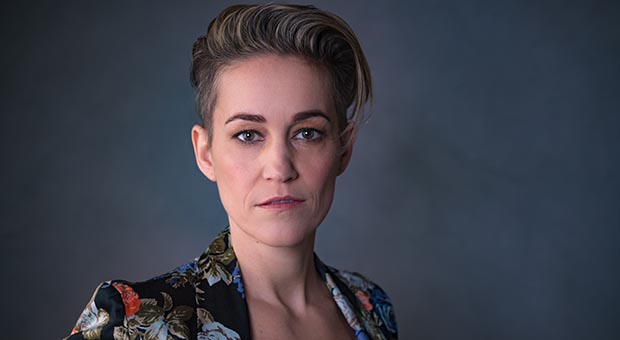
15 Nov The Biz Interview: Taylor Moll of “Rise of the Guardians”
Vancouver native Taylor Moll is the Senior Surfacing Artist on Rise of the Guardians, in theatres November 21st. She spoke to us about what surfacing artists do, the future of 3-D in animation, and her advice to aspiring animation industry enthusiasts.
For those who aren’t aware, can you give us some background on what
the role of a surfacing artist is in an animated film?
A surfacing artist is responsible for giving the raw models the textural or ‘surface” quality directed by the art department. We make the table, wood, the floor, marble. We decide how much dirt peeks through the grass, and where to put moss on rocks. We work out how translucent to make skin or how shiny to make fur. Everything you see in Rise of the Guardians that has colour, and texture, and substance was done by the surfacing department before being handed over to the lighting division.

How did you originally become involved with animation? What influences did you have and what inspired you to make it a career?
I was a photography geek in high school, which was luckily encouraged by my parents. The early nineties saw the mainstream introduction of digital photography, Photoshop, QuarkXPress and the like. After a trip to the Centre for Creative Imaging in Camden, Maine, which sadly no longer exists, I knew I was going to be the greatest digital illustrator that ever breathed. After years of reality checks, I discovered that there was far more work in moving pictures than still ones, especially in Vancouver. I realized that there were careers in digital painting for movies and television, that there was this great balance of art and science available. I wanted to create these amazing scenes that people would remember. if they happened to move, all the better.
Can you walk us through your creative process for Rise of the Guardians?
I was fortunate enough to join the DreamWorks team in 2009 and worked on a few projects before Rise of the Guardians. I came on board indirectly through the research and development team I was working with. Rise of the Guardians was pushing a new direction in the calculation of lighting, where something that was a cartoon could be lit like it existed in the real world. Even though it was a cartoon, the movie makers wanted people to feel like you could reach out and touch it, like it was in our world. It was a struggle to get that science translated into art, but i think it works really successfully. Cartoons aren’t just cartoons anymore.

What can audiences expect to see in Rise of the Guardians that they may not have seen in previous 3-D animation films?
There are a crazy amount of effects in this movie. Most animated features keep the amount of effects sequences lower, because the whole movie is more or less an effect, but in Rise of the Guardians almost every shot has some sort of effects work in it. Crazy sand creatures, living frost patterns, fire, water, freezing water…. and I thought making a thousand little elves was tough.
It’s very common now for animated films to be created in 3-D. How do you think the 3-D process has changed the animated genre?
3-D is something DreamWorks really changed my mind about. I was never a fan of the whole 3-D thing. I thought it was a gimmick and ultimately something that took me out of the movie more than putting me into it. I know a lot of people felt the same way, and there was a big backlash from the movie-going public about it. Nothing ruins a movie faster than crappy 3-D. Luckily, the backlash didn’t phase companies like DreamWorks who wanted to show those same angry people that when 3-D is done well, when it serves a purpose, when it aids the creative story telling process, it works. Not only does it work, it can be freaking awesome! I think as more movies with great 3-D are put out there, people will see, just like I did, that it’s a great addition to the movie experience.
What do you think the future holds for animated films?
I’m really liking this direction animated movies are taking where the movies aren’t just for 3-11 year olds anymore. They’re a little dark, a little twisted, a little more, well, grown up.

Are there any books that have been helpful to your creative journey and that you would recommend for aspiring animators and surfacing artists?
I can’t comment on anything for animators, but for surfacing, or digital artists, there’s a great book Digital Texturing and Painting by fellow Canadian, Owen Demers. It was a book I used when starting in the industry, so when I realized I was going to be working with him on Rise of the Guardians it was quite a kick!
For those artists that are more interested in the technical side than the artistic, and yes, there is a lot of technical knowledge required to be a surfacing artist, there’s the book Writing Mental Ray Shaders: A Perceptual Introduction by Andy Kopra. Reading through that book makes me realize just how much I don’t know.
The magazine Cinefex is an industry standard. Informative and beautiful. Doesn’t get much better than that.
What advice would you give to someone who wants to pursue a career in animation?
There are a lot of different careers within the animation industry. Modeling, surfacing, matte painting, rigging, cloth and hair simulation, animation, effects, lighting, compositing, story, production, editorial…. The list keeps going. The key is to know what you want to do, and then get the foundation to be able to do that professionally. You don’t always need to go to expensive schools for years to get into the industry. Pick the education that works best for you and then be the best in your class. Work your butt off, absorb everything you can, test, push boundaries, figure out what works and more importantly what doesn’t. This is a challenging career path, so start challenging yourself early on, and you’re halfway there.
Rise of the Guardians opens on November 21st. You can read more about the film at RiseoftheGuardians.com.






